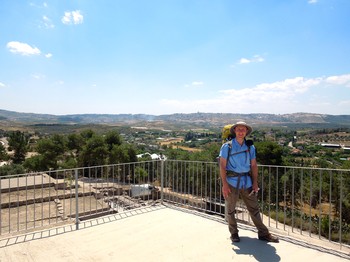“The experience of Holy Ground is to dwell in the fullest sense of beauty — it is ekstasis: a stepping outside of the brokenness or fragmentation of ordinary life and into a wholeness of self, time, and place,” wrote the Rev. Lawrence Bartel in a reflection upon a hike.
This month, Bartel hiked the Jesus Trail from Nazareth to Capernaum in Israel following the conclusion of the Mosaic of Peace tour, a conference hosted by the Presbyterian Peacemaking Program and held in Israel/Palestine.
The Jesus Trail is a 40-mile hike through the Galilee region of Israel and was established by Israeli Maoz Inon and David Landis, a guidebook writer from Pennsylvania, according to the 2012 New York Times article “Hiking Through Biblical Backcountry.” The pair met while hiking in Israel in 2005 and crafted their plan over the next few years. The path of the Jesus Trail was officially blazed by the Society for the Protection of Nature in Israel in 2008 and opened the next year.
Bartel saw this New York Times article when it was first published and was intrigued by the idea of it. He is no stranger to making pilgrimages and extended hikes — Bartel hiked the final 200 miles of the Camino de Santiago in 2012 and did a 120-mile wilderness hike through his native Adirondacks last fall.
As pastor at Niccolls Memorial Church in Old Forge, New York, Bartel has created a ministry at his church that is focused on getting church members out into the Adirondack Mountains and taking Sabbath walks.
“For me, walking is essentially prayer and in that praying is listening,” Bartel said.
For the Jesus Trail, Bartel carried merely a backpack containing two sets of clothes, small souvenirs from the Mosaic of Peace tour, his tablet for reading scripture, his camera and his water bottle.

Bartel used Hiking the Jesus Trail, a guidebook created specifically for this journey, to plan out his trip. This included booking his stays each night, one of which was at an organic goat farm and eco-lodge in Ilaniya, Israel.
As Bartel journeyed along this storied path, he was able to visit locations that were meaningful not only to him, but to the church’s history as a whole.
“One of the joys of the Jesus Trail is that I read one of the Gospels every day of the trail,” Bartel said. “I was reading the Gospel in new ways and paying close attention to where Jesus was, how he moved from place to place, and I could feel scripture coming alive in a new way as I was walking some of the same terrain that he was walking at that point.”
Some locations Bartel came upon while hiking the Jesus Trail were the town of Mash’had where Jonah might have come from, the Church of the Multiplication of Loaves and Fishes where Jesus might have fed the 5,000, and St. Peter’s Table, where Jesus served his disciples breakfast after his resurrection when they had finished fishing on the Sea of Galilee.
A few non-biblical hotspots along the trail are Kibbutz Lavi, manufacturer of synagogue furnishings, and the Cliffs of Arbel, famous from the battle that took place there between Islamic warriors and the Crusaders in 1187.
Bartel described this hike as being unlike the others that he has been on for a very specific reason.
“It was so significantly different because the story that preceded me was a story that I heard about since I was such a young person and it was a story that lived in my imagination for so many years,” he said, adding that he’ll carry this experience with him forever.
“For me, the travel doesn’t end when the journey concludes.”

